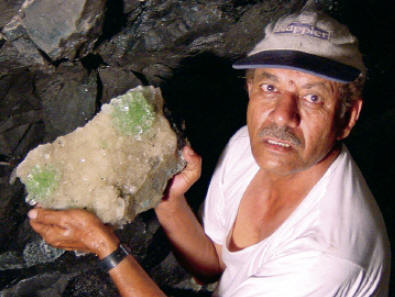
Fasi Makki with a freshly mined specimeninside the huge pocket in the well inMomin Akhada, India. S. Makki photo.
Maharashtra state in India has beenknown since the 1970’s as a prolificsource of specimens containing apophyllite-(KF), a range of zeolite group minerals and several other associatedspecies. Everyone knows that “Indian zeolites”(using the term loosely here, to includeapophyllite and other non-zeolitespecies) are abundantly available; literallytonnes of this material are shippedevery year and, inevitably, much of it isof relatively low value. The earliest finds,of course, caused quite a stir in the collectingcommunity, but enthusiasm beganto wane when it became clear just howhuge the potential for future specimen recoveryfrom the Deccan Traps really wasand now, for many collectors, the Indianspecimens are no longer among the mostdesirable of material. The vast majorityof these specimens come from the industrialbasalt quarries, but there are alsosmall, and usually very limited finds, discoveredwhile digging wells and foundationsfor various construction projects.

“Disco ball” apophyllite-(KF) on stilbitefrom the 2001 find in Momin Akhada, Rahuri,India. 13 cm tall. G. and J. Spanncollection.
The discoveries of green apophyllitemade during the course of well-diggingin the Momin Akhada village nearRahuri, were surely one of the rare situationsin which specimens from India excitedthe whole collecting community.
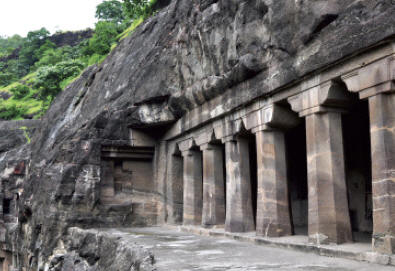
About 2000 years old buddist temples carvedin basalts in Ajanta village in DeaccanTraps, India. J. Gajowniczek photo.
(Strictly speaking and based on its compositionthis mineral should be calledapophyllite-(KF), but we will refer to ithere simply as “apophyllite”). Thesespectacular and aesthetic sphericalarrangements of radiating green crystalsquickly became known by collectorsas “disco balls”. In the last 12 years, in the Momin Akhada area, there have beenthree wells that have yielded these highquality green apophyllites. All threefinds were relatively small and producedonly a very limited number of specimens.
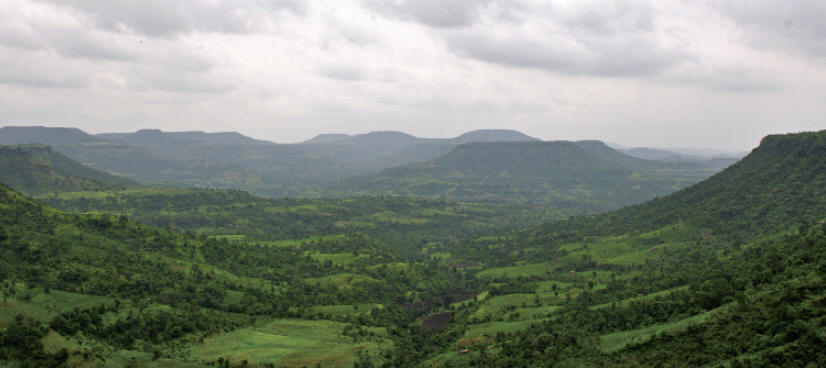
Typical view across the Deccan Traps in Maharastra, India. J. Gajowniczek photo.
The majority of them disappeared fromthe market almost immediately, readily finding places in private collections andleaving many collectors looking for themin vain.
The most recent of these pocketsfrom the Momin Akhada area was discoveredin March 2013 and, once again,delivered some exceptional specimenmaterial.
GEOLOGY ANDSPECIMEN COLLECTING
The Deccan Traps volcanic provincecovers about half a million square kilometersof western India, including thewhole of Maharashtra state, with lavas to a thickness of about 1500 m. To putthis in context, half a million square kilometersis larger than the state of California,and roughly equivalent to theland area of Spain. Maharashtra isIndia’s third largest state, with a surfacearea of 308,000 square kilometers;it is also one of India’smost populous states andthe source of the majorityof mineral specimens.
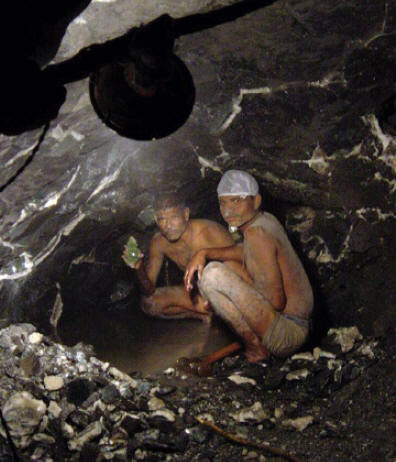
Dirty miners inside the first “disco ball”apophyllite pocket during collecting. Noteelectric light in use. S. Makki photo.
This giant volcanic provincewas forming from 75million years ago,soon after the timethat India separatedfrom Madagascarand started to moveto the north, to about40 million years agowhen India had alreadycollided with the Asian continent.
This collision waspart of the Alpine orogenythat resulted in the formation ofmajor mountain ranges including theHimalayas. The most important period ofvolcanic activity occurred between about65 and 60 million years ago, from lateCretaceous to early Paleogene times,when India was moving over the socalledReunion hotspot. During that relatively narrow timeframe the vast majorityof the traps were formed.
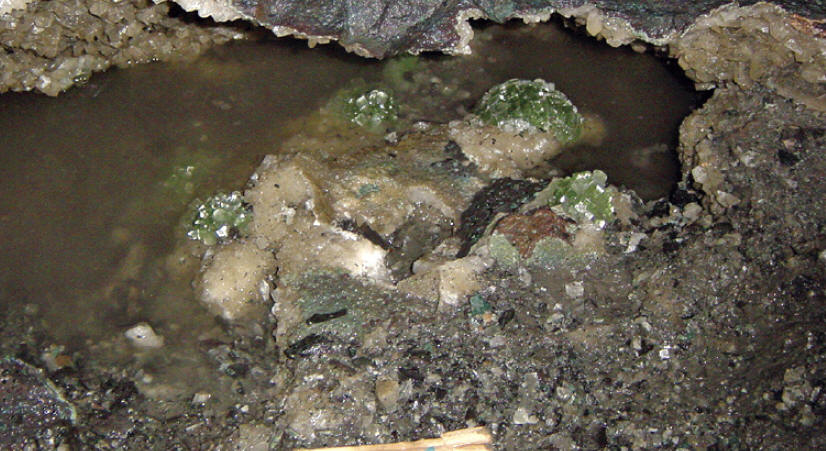
“Disco ball” apophyllites in situ on thefloor of the pocket found in 2001 in MominAkhada. S. Makki photo
The Deccan Traps comprise literallyhundreds of lava flows, stacked in layers,one upon another as successive flowsebbed and cooled. The thickness of individualflows varies from one to tensof meters, and both spilitic and tholeiiticbasalts are represented; indeed, thecomposition of the lava can change,sometimes even within a single flow.
But probably the most distinctive andimportant feature of these lavas wastheir very low viscosity resulting inthe rapid “flooding” of huge areas. Someof the individual flows can be observedover distances of tens of kilometers.

Map of part of Asia showing inserts of theMumbay area and the location of MominAkhada near Rahuri.
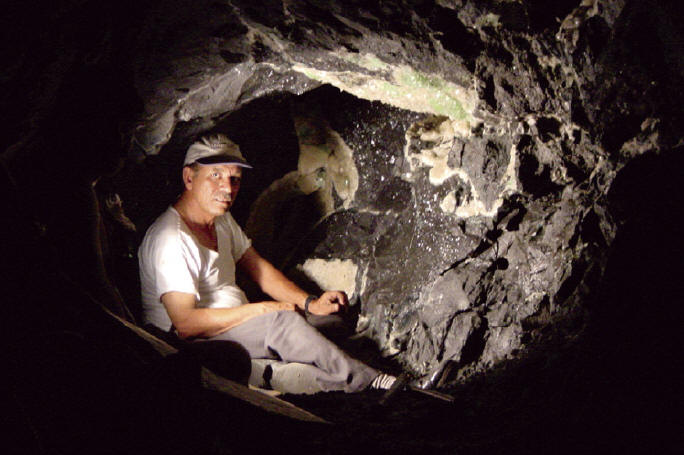
Fasi Makki collecting apophyllites in the pocket in 2001. S. Makki photo.
When volcanic eruptions occur andlava is released onto the earth’s surface, the pressure and temperature thatcaused the magma to be molten changevery rapidly. As the lava flows it coolsvery quickly, initially on the surface ofthe lava flow. Fluid (gasand liquid) vesiclesform in the lava as the pressure drops and the“bubbles” of fluid move towards the coolingsurface of the flow. The coolingprocess, however, forms a thin solidcrust on the lava which prevents thesebubbles of fluid from escaping so that, inthe upper part of the flow, these vesiclesbecome concentrated and eventuallythey coalesce, forming larger and largerfluid-filled cavities. Later, as the interiorof the lava flow cools, the magma solidifiesto form basalt, and minerals begincrystallizing from the cooling fluids inthe vesicles. This explains why the specimenpockets in the Deccan Traps (and,indeed, in many other lava fields aroundthe world) occur in particular horizons within the volcanic flows. The mineralsthat can crystallize in such cavities caninclude silica (as agate, or jasper), zeolites,apophyllites, calcites and others.
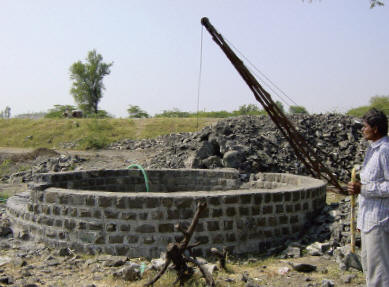
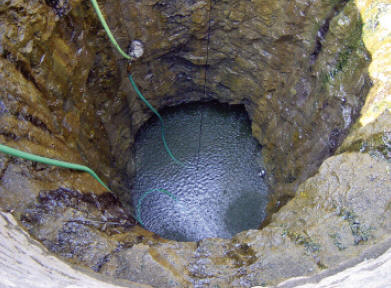
Well in Momin Akhada (known as WellNumber 1) in which the original discoveryof the “disco ball” apophyllites was madein 2001. S. Makki photos.












 YueGongAnBei 44051102000467
YueGongAnBei 44051102000467


 |
|